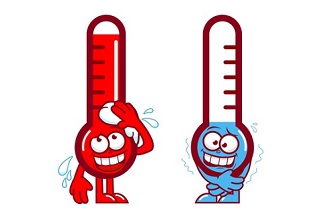Temperatura é a grandeza física que está associada ao nível de agitação das
moléculas, quanto mais agitadas, maior a temperatura. Já o calor mede a energia térmica em movimento entre dois corpos com temperatura diferentes, ou seja, é a transferência de energia entre dois corpos.
Medidas de Temperaturas
Atualmente utilizam-se três escalas para a medida da temperatura. Para construir uma escala, precisamos de dois pontos fixos, que hoje são o ponto de fusão do gelo e o ponto de ebulição da água.
● Escala Celsius: utilizada na maioria dos países, tem como pontos fixo, 0°C e 100 °C, que são, respectivamente, a temperatura de fusão do gelo e de
ebulição da água, a uma pressão de 1 atm.
● Escala Fahrenheit: utilizada em países ingleses, e o seus pontos fixos são
32 graus Fahrenheit e 212 graus Fahrenheit, a uma pressão 1atm.
● Escala Kelvin: utilizada na ciência, sendo a unidade padrão do SI, que
estabelece um limite inferior para a temperatura de um corpo (-273 °C = zero kelvin), sem a necessidade de limite superior.
Equilíbrio Térmico
Equilíbrio térmico é a transferência de energia térmica que ocorre entre dois corpos em contato e isolados do meio externo. Nesse processo o corpo mais quente (maior temperatura) transfere calor para o corpo mais frio (menor temperatura) até que ambos tenham a mesma temperatura.
Capacidade Térmica
A capacidade térmica é a capacidade de um corpo de receber ou perder calor e é a quantidade de calor necessário para que um corpo varie a sua temperatura em uma unidade (1°C ou 1 grau K). A capacidade térmica é calculada pela razão entre a quantidade de calor (Q)
recebida (ou cedido) por um corpo e a variação da temperatura.
Calor Específico
Calor Específico é a quantidade de calor necessário para que cada grama de
uma certa substância sofra uma variação de temperatura correspondente a 1°C (ou 1 k).
Nomes: Camila, Daniella, Gabrielly, Isabella, Maria Joana e Valentina
TEMPERATURE AND HEAT
Temperature is the physical greatness that is associated with the level
agitation of molecules, the more agitated, higher the temperature. Already the heat measures thermal energy in movement between two bodies with different temperatures, that is, is the transfer of energy between two bodies.
Temperature measurements
Actually, three scales are used to measure the temperature.To build a scale, we need two fixed points, which today are the melting point of ice and the boiling point of water.
● Degrees Celsius: used in most countries, the fixed points on the Celsius
scale are 0 degrees and 100 degrees, which are the melting and boiling
temperature at a pressure of 1 atm.
● Degrees Fahrenheit: used in English countries, the fixed points are 32
degrees Fahrenheit and 212 degrees Fahrenheit which are the melting and
boiling temperature, at a pressure of 1atm.
● Kelvin degrees: used in science being the SI standard unit, which
establishes a lower limit for the temperature of a body (-273°C = zero kelvin) without the need for an upper limit.
Thermal balance
Thermal equilibrium is the transfer of thermal energy that occurs between two bodies in contact and isolated from the external environment. In this process, the warmest body (highest temperature) transfers heat to the coldest body (lowest temperature) until both have the same temperature.
Thermal capacity
The thermal capacity is the capacity of a body to receive or lose heat and is also the quantity of heat that is necessary for a body to vary its temperature by one unit (1 degree Celsius or 1 degree Kelvin). The thermal capacity is calculated by the reason between the amount of heat (Q) received (or given) by a body and the temperature variation.
Specific heat
Specific heat is the amount of heat needed for each gram of a certain substance to undergo a temperature variation corresponding to a 1 degree celsius or 1 K.
Names: Camila, Daniella, Gabrielly, Isabella, Maria Joana and Valentina

